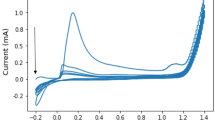Abstract
Nitrate reductase (NR) from the plant Arabidopsis thaliana has been employed in the development of an amperometric nitrate biosensor that functions at physiological pH. The anion anthraquinone-2-sulfonate (AQ) is used as an effective artificial electron transfer partner for NR at a glassy carbon (GC) electrode. Nitrate is enzymatically reduced to nitrite and the oxidized form of NR is electrochemically reduced by the hydroquinone form of the mediator (AQH2). The GC/NR electrode shows a pronounced cathodic wave for nitrate reduction and the catalytic current increases linearly in the nitrate concentration range of 10–400 µM with a correlation coefficient of 0.989. Using an amperometric method, a low detection limit of 0.76 nM (S/N = 3) was achieved. The practical application of the present electrochemical biosensor was demonstrated by the determination of nitrate concentration in natural water samples and the results agreed well with a standard spectroscopic method.
Graphical Abstract









Similar content being viewed by others
Notes
In all cases we assume that the heme cofactor of NR relays electrons rapidly from AQH2 to the Mo active site.
Abbreviations
- AQ:
-
Anthraquinone-2-sulfonate
- CV:
-
Cyclic voltammetry
- FAD:
-
Flavin adenine dinucleotide
- GC:
-
Glassy carbon
- MV:
-
Methyl viologen
- NADH:
-
Nicotinamide adenine dinucleotide
- NHE:
-
Normal hydrogen electrode
- NR:
-
Nitrate reductase
References
Rajeshwar K, Jorge IG (1997) Environmental electrochemistry. Academic Press, San Diego
Moorcroft MJ, Davis J, Compton RG (2001) Talanta 54:785–803
Yu WT, Jiang CM, Ma Q, Xu YG, Zou H, Zhang SC (2011) Atmosph Res 101:460–468
Cameron KC, Di HJ, Moir JL (2013) Ann Appl Biol 162:145–173
Lunau M, Voss M, Erickson M, Dziallas C, Casciotti K, Ducklow H (2013) Environ Microbiol 15:1492–1504
Kempster PL (1981) Water SA 7:61
Phillips WEJ (1971) Food Cosmet Toxicol 9:219–228
Fewtrell L (2004) Environ Health Perspect 112:1371–1374
Hafezi B, Majidi MR (2013) Anal Meth 5:3552–3556
Gamboa JCM, Pena RC, Paixao TRLC, Bertotti M (2009) Talanta 80:581–585
Cataldo DA, Haroon M, Schrader LE, Youngs VL (1975) Commun Soil Sci Plant Anal 6:71–80
Tsai M-C, Zhuang D-X, Chen P-Y (2010) Electrochim Acta 55:1019–1027
Badea GE (2009) Electrochim Acta 54:996–1001
Reyter D, Chamoulaud G, Bélanger D, Roué L (2006) J Electroanal Chem 596:13–24
Zhang X, Wang J, Wang Z, Wang S (2005) Synth Met 155:95–99
Hille R (1996) Chem Rev 96:2757–2816
Hille R, Hall J, Basu P (2014) Chem Rev 114:3963–4038
Redinbaugh MG, Campbell WH (1985) J Biol Chem 260:3380–3385
Crawford NM, Smith M, Bellissimo D, Davis RW (1988) Proc Natl Acad Sci USA 85:5006–5010
Vaucheret H, Kronenberger J, Rouzé P, Caboche M (1989) Plant Mol Biol 12:597–600
Cosnier S, Da SS, Shan D, Gorgy K (2008) Bioelectrochemistry 74:47–51
Quan D, Shim JH, Kim JD, Park HS, Cha GS, Nam H (2005) Anal Chem 77:4467–4473
Adeloju SB, Sohail M (2011) Electroanalysis 23:987–996
Cosnier S, Galland B, Innocent C (1997) J Electroanal Chem 433:113–119
Cosnier S, Innocent C, Jouanneau Y (1994) Anal Chem 66:3198–3201
Ferreyra NF, Solis VM (2004) Bioelectrochemistry 64:61–70
Fischer K, Barbier GG, Hecht H-J, Mendel RR, Campbell WH, Schwarz G (2005) Plant Cell 17:1167–1179
Bernhardt PV (2006) Aust J Chem 59:233–256
Da SS, Shan D, Cosnier S (2004) Sens Actuators. B B103:397–402
Patolsky F, Katz E, Heleg-Shabtai V, Willner I (1998) Chem Eur J 4:1068–1073
Glazier SA, Campbell ER, Campbell WH (1998) Anal Chem 70:1511–1515
Kirstein D, Kirstein L, Scheller F, Borcherding H, Ronnenberg J, Diekmann S, Steinrucke P (1999) J Electroanal Chem 474:43–51
Moretto LM, Ugo P, Zanata M, Guerriero P, Martin CR (1998) Anal Chem 70:2163–2166
Willner I, Katz E, Lapidot N, Bauerle P (1992) Bioelectrochem Bioenerg 29:29–45
Lambeck I, Chi J-C, Krizowski S, Mueller S, Mehlmer N, Teige M, Fischer K, Schwarz G (2010) Biochemistry 49:8177–8186
Kalimuthu P, Fischer-Schrader K, Schwarz G, Bernhardt PV (2013) J Phys Chem B 117:7569–7577
Wipf DO, Wehmeyer KR, Wightman RM (1986) J Org Chem 51:4760–4764
Meckstroth ML, Norris BJ, Heineman WR (1981) Bioelectrochem Bioenerg 8:63–70
Ferreyra NF, Dassie SA, Solis VM (2000) J Electroanal Chem 486:126–132
Brody MS, Hille R (1999) Biochemistry 38:6668–6677
Zare HR, Memarzadeh F, Ardakani MM, Namazian M, Golabi SM (2005) Electrochim Acta 50:3495–3502
Acknowledgments
We gratefully acknowledge support from the Australian Research Council (DP120101465).
Author information
Authors and Affiliations
Corresponding author
Additional information
Responsible Editors: José Moura and Paul Bernhardt.
Electronic supplementary material
Below is the link to the electronic supplementary material.
Rights and permissions
About this article
Cite this article
Kalimuthu, P., Fischer-Schrader, K., Schwarz, G. et al. A sensitive and stable amperometric nitrate biosensor employing Arabidopsis thaliana nitrate reductase. J Biol Inorg Chem 20, 385–393 (2015). https://doi.org/10.1007/s00775-014-1171-0
Received:
Accepted:
Published:
Issue Date:
DOI: https://doi.org/10.1007/s00775-014-1171-0




